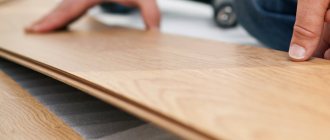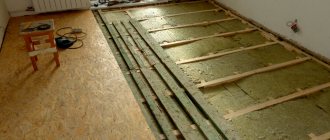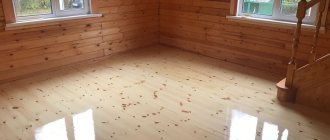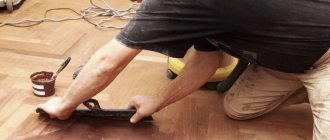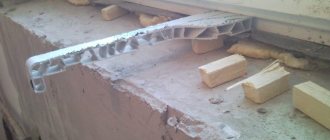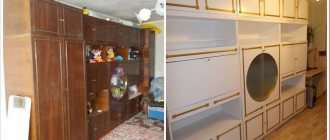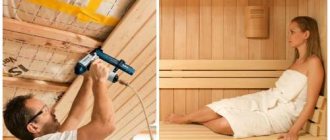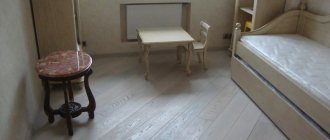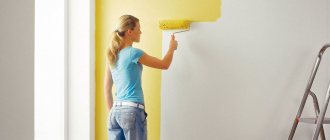One of the biggest problems with natural wood flooring is wear and tear, which can cause the floor to lose its spectacular appearance and require expensive repairs. Significant savings, in this case, will be contributed by painting the parquet, which has several different options. With its help, the floor covering will restore its stylish appearance, plus this will significantly extend its service life.
You don’t have to wait until the surface wears out to change its color; you can do it at any time
Parquet floor painting options
For many people, old and overly worn parquet floors cause a lot of inconvenience. Repairing it, let alone completely changing it, will require quite a large investment, which many of them are not ready for. It is for this reason that owners of apartments with this type of flooring have a question about whether it is possible to paint the parquet and what is needed for this.
Painting a parquet floor is enough to transform the entire interior
You can paint parquet with your own hands using several types of paints and varnishes, with the help of which the floor will regain its presentable appearance, namely:
- parquet paint, specially designed for painting the surface of finishing materials made of natural wood;
- stain, the properties of which allow you to restore the natural texture of the parquet board;
- tinting varnish, which, in addition to coloring, also has protective properties, protecting the parquet from the negative effects of high humidity;
- mastic that has various properties that restore the texture of wood, which can not only give the parquet its original appearance, but also reliably protect its surface.
Each of the above options for restoring the paint layer of a parquet floor covering has certain nuances, to comply with which you must have both certain skills and various specialized tools. That is why the simplest and most affordable option is to paint the floor covering, which will require minimal knowledge and a small amount of tools, often available in any apartment.
As in any other matter, before you start painting, you need to study the base
Modern manufacturers of paints and varnishes supply large quantities of parquet paints to the domestic market, made on a water-soluble acrylic or latex base, due to which these enamels have excellent performance properties and are quite simply applied to a wooden surface. A wide range of colors of water-soluble acrylic and latex enamels allows you to easily match them to any interior design.
Particularly popular is the option of painting parquet flooring white, which many designers recommend using as a neutral element that has an excellent combination with objects of any other shade, and in addition hides minor defects of the parquet board well.
Making your own stain
If you couldn’t find the right shade of stain in the store, you can prepare the coloring composition yourself.
There are several ways:
- Boil 200 grams of larch bark in 250 ml of water (the result is a reddish stain).
- Boil a few tablespoons of crushed dried walnut shells in 250 grams. The prepared broth is cooled and mixed with 1 tsp. soda (it turns out a brown stain).
- Tea leaves of varying strength will help tint the wood into different shades of brown.
- A strong solution of potassium permanganate will paint the parquet red.
How to properly apply paint to a parquet floor
The big advantage of painting a parquet floor with acrylic or latex enamel is that the entire process can be done with your own hands, without the need to involve third-party specialists, which will make it possible to significantly save on floor repairs.
For these purposes, it is worth purchasing the necessary paint, putty, a special primer for wooden surfaces, sealant, an electric sander with a set of sandpaper and several brushes with rollers, after which you can safely start painting, strictly following all the steps listed below:
Tools and consumables for painting are not that expensive and will definitely come in handy around the house
At the first stage, the so-called sanding is carried out, which is a thorough removal of all paint and varnish materials that were previously applied to the old parquet. This is done using a grinding machine, onto which coarse-grain sandpaper is mounted. As the floor is treated, it is gradually changed to fine-grained. Before sanding, it would be useful to place a protective film on the walls, in the lower part, which will protect their decorative finish from accidental damage.
After sanding, it is necessary to carefully inspect all parquet boards for their deformation and the presence of mechanical damage, which can significantly spoil the appearance after painting the floor. Any minor damage found is treated with putty and re-sanded, and heavily damaged boards of the old parquet are replaced with new ones.
Drum type machine for parquet scraping
At the third stage, all the seams of the parquet boards are treated with sealant to protect against moisture getting inside, after which the room is completely cleaned, removing all dirt and grease marks on the floor. Next, apply a layer of primer to the floor covering and leave for a couple of hours until completely dry. The primer is needed in order to fill all the pores in the parquet boards and for more effective adhesion of the paint to the surface of the floor covering, as a result of which the service life of the parquet board is significantly increased.
What is scraping and how can it be carried out?
Sanding is a technology for leveling wood surfaces by scraping (removing a thin layer of chips). This process can be carried out using a scraping machine, an electric planer, or a hand scraper. After this procedure, the damaged floor will look like new.
cycle
A manual scraper is a metal scraper with a wooden handle. It perfectly removes paint or varnish layers. A medium-sharp metal plate is inserted inside the tool, which helps remove wood chips without damaging the structure of the dies.
If you have the opportunity to rent a sanding machine, take advantage of it. This will save you time and effort.
Sanding with feet
When sanding parquet, it is recommended to sand it with your feet rather than your hands. This way the pressing force is higher and less effort is wasted. To do this, you need to glue sandpaper to the sole and rub the floor.
a scraper made from improvised tools
When to paint parquet
Although hardwood floors last a long time, they do not last forever. A clear sign that it is time to renew the flooring will be wear and tear on the flooring. If it has worn down, nicks have formed on the boards, and the varnish has worn off, then repairs are necessary. Not everyone knows whether the parquet can be painted or whether it will have to be completely replaced. In fact, there is nothing complicated about it. You can carry out all the repair work yourself, and it will cost less than completely replacing the materials with new ones. A painted board will look renewed and will last for several more years or decades.
General information
But it is very expensive to completely replace the flooring. It is made of wood, which makes it possible to subject it to repeated processing. In this article we will consider the option of partial restoration of parquet flooring at home, depending on the defect that appears. There are 2 types of partial repair of such flooring:
- Correction of individual dies.
- Surface.
The second includes the following types: eliminating cracks, chips and gouges, restoring or changing the shades of the board. One of the restoration methods is to renew the old parquet without sanding, and we will also consider this.
( 2 ratings, average 4.5 out of 5 )
Selection of materials for painting
To restore the coating, you can use the classical method. A layer of stain is applied to the base to highlight the wood structure, and then varnish is used. However, this method is not suitable for cases where the boards are very worn. In this situation, you will need to use a coating coating. When restoring the floor, water-soluble paints are used. Parquet is painted using acrylic or latex enamels. They have a high wear resistance threshold. To select the material, follow the following recommendations:
- Please ensure that the paint is intended specifically for floors. The boards will be constantly exposed to stress, so the material must withstand them.
- Is it possible to paint parquet floors with a different color paint? It is possible, but not recommended. It is best to choose a shade 1 - 2 shades darker than the previous one. You should not experiment with colors that are too light (especially white), as they will be difficult to apply.
- If the parquet pattern is beautiful and you want to preserve it, you need to choose a material that does not affect the structure of the boards. Most often, this is not a very dense paint, which only refreshes the shade.
- Pay attention to the absorbency of the wood and the type of parquet board. For example, painting pine should be done only with paints that are designed for soft wood. Classic materials are suitable for oak coverings.
Water-soluble acrylic enamels
Acrylic enamel is a fairly popular paint for parquet. She has an impressive list of positive qualities. We are talking about an affordable price, resistance to temperature changes, as well as safety during application. The paint dries quickly and there is no specific odor during work. In addition, acrylic enamel allows wood to “breathe” because it has good permeability. The renewed coating will last 5 – 10 years. In most cases, semi-gloss enamel is purchased for floors. When it dries, it forms an elastic film with high strength on the surface.
Latex enamels
This is one of the types of water-soluble materials. Latex enamel has the same advantages as acrylic enamel. The only difference is the service life of the coating. If you use this paint, you can forget about repairs for the next 15 to 20 years. After application, surface care will become easier. It will be easier to clean the floors from dirt, since a dense glossy film will form. Another plus is that latex enamel is applied in a thin layer and does not affect the structure of the boards. The drawing remains the same. The only possible disadvantage is insufficient resistance to sub-zero temperatures.
Preparing for work
Before you begin restoring old parquet, you need to properly prepare it for work. To do this, follow the following sequence of actions:
- First, remove the remnants of the previous coating. This can be varnish, paint or primer. You need to get to the wood itself. It is most convenient to use a grinding machine for this. You can do this manually, although it will take much more time and effort. Before carrying out work, it is necessary to protect your eyes and ears from dust entering them. Also, take care of a respirator in advance to protect your respiratory system.
- When sanding, use different attachments alternately. First, use sandpaper with a rough texture. It is used to clean the surface diagonally. The overlap with the subsequent path should be 5 cm. Then use a medium-grained nozzle. They also move diagonally, but in the opposite direction. The last step is to sand the floors with fine-grained sandpaper.
- Check to see how well the floors are cleaned. If a sanding machine is used, the parquet must be sanded manually in the corners.
- After sanding is completed, the room must be thoroughly cleaned of dust. The surface is vacuumed and checked for obvious chips or cracks. It is best to replace boards with severe defects before painting.
Severe cases
In three cases, independent restoration of parquet will require significant expenditures of money, time and labor:
- Heavily worn, unkempt and trampled parquet with visible hollows and wavy cracks in the tiles. In this case, most often you can do without replacing the parquet flooring, but it is best to entrust the restoration of the parquet to professionals: it will cost less.
- The floor is swollen after heavy flooding over the entire area; the dies (parquet flooring) have come off the base. This floor needs to be re-laid. After drying in a stack, old parquet flooring can be used, but the whole complex of sanding and varnishing work is also necessary.
- The dies are darkened, the wood is loose, and when pressed lightly, the awl goes 5 mm or more into the wood. The parquet floors are rotten and moldy. Required with drying the room and preparing the base floor.
In other cases, restoring parquet with your own hands is quite possible. If parquet work is timed to coincide with the renovation of the premises, it is carried out last. Let us first consider what materials and technological operations are required for this.
Applying paint
After completing the preparatory stage, you can paint the old parquet with a pre-selected enamel. To do this you will need to choose the right tools. You can use a regular brush. However, this will take a lot of time. Therefore, it is most often recommended to buy a roller or sprayer. You should not use products made from foam rubber, as they leave marks and do not paint uneven surfaces very well. Even after drying, it will be noticeable that the paint applied unevenly. To paint the floor, it is better to purchase a roller made of wool or mohair (with a long handle). If liquid paint is used for repair work, a special sprayer can be used. In addition, it is suitable for those cases when you need to process a large area, and doing it manually is difficult. Before painting the parquet, you must once again make sure that there is no dust or other visible contaminants left on the boards. The further process consists of the following steps:
- Make sure there is access to fresh air in the room. Vapors most often have a negative effect on the human body.
- To avoid damaging your clothes, use a special suit. Also wear a respirator to protect your respiratory tract.
- The composition must be applied from the far corner of the room, gradually moving towards the exit.
- Make sure that the paint does not pool and form uneven spots. Wipe them immediately with a dry cloth and reapply the enamel, as it dries quickly. For the same reason, you need to immediately erase marks if you accidentally hit walls or any objects.
- If additional varnish is applied, the floor will need to be covered in several layers. Each subsequent one is placed across the previous one. At least 2 days should pass between application of layers.
Water-soluble enamels dry on average 10 – 12 hours. It is necessary to wait this period before starting to apply a new layer (if more than one layer will be applied). To ensure that no traces remain on the painted floor, it is recommended to install furniture no earlier than 1 - 2 weeks after the repair. But you can walk on the boards the next day.
Stages of restoring worn-out areas
1. First, we need to thoroughly clean the problem areas. Usually the varnish in these places is no longer there and the visible texture of the wood has already been worn down beyond recognition. This can be done using a manual sanding machine.
2. For this you can use sandpaper No. 40 -60. We thoroughly clean the areas of abrasions. As a result of this work, “bald patches” (islands of bare wood) form on the surface. I must say right away that the grinding process is quite dirty. 3. The easiest way to protect the room from dust is to cover the sanding area with a piece of polyethylene. You can also cover the edges of the oilcloth with old rags. The entire structure should resemble a canopy over the work area of the grinding machine.
4. After turning off the device, you need to give time for the dust to settle. Just close the edge of your makeshift hut and leave everything for a while. And then carefully collect the settled dust with a vacuum cleaner and a damp cloth. 5. The next step is very important for this work. Before varnishing cleaned surfaces, it is necessary to prevent darkening of the wood texture. To do this, you can use wood impregnation. All our actions must first be carried out in places less noticeable to the eye. Since the materials used can produce an undesirable effect on the texture of the wood (it can darken or, on the contrary, become lighter) and even under a layer of varnish these color changes will be visible. After making sure that the color of the wood remains unchanged, you can continue working on visible places.
6. First coat the cleaned areas with varnish. Sometimes it takes several coats to ensure the surface is even and there is no uneven depression left. And only when you have restored the clearings can you varnish the entire surface. 7. I repeat once again that this repair is cosmetic and we do not remove all the old varnish. Therefore, before starting work, it is necessary to check the compatibility of the old and new varnishes. Or it’s easier to say, apply the old one to an inconspicuous area of the floor and let it dry. If everything went well (the varnish has dried and the old one has not peeled off), feel free to start working. I recommend “Alpina” gloss parquet varnish for this type of work.
It dries perfectly, fits perfectly on the surface, shines, has virtually no odor and is very durable.
In addition, it is quite cheap and sold in small containers, which is important for cosmetic repairs. The advantage of this restoration method is minimal physical effort and material costs. So you can update and revive the old parquet at any time, without waiting for a global renovation and without covering scratches and bald spots with rugs and chairs
Article rating /
Give your rating!
Application of varnishes for parquet coating
The most common transparent or tinted composition for treating wood and preserving its original natural appearance is varnish. It creates a protective film on the wood that prevents the parquet board from absorbing moisture, and also protects the floor from scratches, chips, splinters and deformation due to temperature changes.
There are water-based and acrylic-based parquet varnishes, alkyd varnishes, and quick-drying nitro varnishes. Each type has undeniable advantages and disadvantages. The advantages of parquet varnishes include:
- No wood painting. The parquet retains its natural color;
- Resistance to moisture and changes in ambient temperature;
- A protective layer that preserves the board from external influences;
- Aesthetically attractive appearance;
- Low cost.
But varnish for parquet boards also has some disadvantages. This:
- Long drying time of the composition. Nitrovarnishes emit harmful fumes, although they dry quickly;
- Cracks that appear over time on the varnish surface are very noticeable;
- To re-process, it is necessary to completely remove the previous layer and re-process the wood;
- Requires special equipment for application;
- Most often not resistant to alcohol.
Nevertheless, varnishing parquet boards does not go out of fashion and is one of the most reliable ways to protect floors. And visually, the varnished board looks attractive. High-quality modern varnishes allow you to avoid most of the shortcomings.
How to repaint an old varnished door (without sanding or removing the varnish)
The doors were installed here about 20 years ago, wooden, pine, under a thick layer of glossy varnish.
In general - as it was fashionable then. And in their new form they looked so-so, and the fire that happened at the dacha only worsened their appearance. This is what the “before” 0 wooden doors looked like, under a thick layer of varnish This is what the “before” 0 wooden doors looked like, under a thick layer of varnish
Yes, I know, among my readers there are many lovers of natural wood. But, my friends, I do not consider third-rate pine with knots and defects to be a beautiful type of wood, the preservation of whose appearance is worth fighting for.
Natural wood is not always beautiful Natural wood is not always beautiful
What I needed for the conversion:
- metal dishwashing sponge, 100-grit sandpaper, soft synthetic brush
- degreaser
- wood putty, rubber spatula
- adhesive primer (it took 100 grams)
- universal acrylic semi-matte enamel in beige color (it took about half a liter)
- one day time
The sequence of actions in this case is as follows (and this, of course, applies to lining, and to wooden furniture, and to MDF too).
First, I go over the door a little with 100-grit sandpaper. By “a little” I mean that I sand for literally a minute - I just need small micro-scratches on the varnish, and not remove the varnish in principle (which, by the way, I do more often I absolutely do NOT recommend doing anything before painting with paint)
Parquet oil
An environmentally friendly method of treating floors, which appeared on the market of paints and varnishes relatively recently, is oil compositions. Unlike varnishes, it impregnates and protects the wood more deeply, and it dries in the shortest possible time. The absence of harmful fumes during use also plays an important role in choosing this coating method for a home where there are children or people with allergies.
The oil is applied in one layer, which does not require additional equipment or any special skills. Does not crack over time and is resistant to alcohol. But, of course, like any composition, the oil also has its disadvantages:
- Oil coating does not protect the parquet board from sudden temperature changes;
- Changes the shade of wood, makes it darker, although it emphasizes the structure;
- Does not create an additional layer that protects the parquet from scratches and impacts, and your feet from splinters;
- It has a higher cost than varnish compositions.
Despite the presence of negative characteristics, oil compositions are perfect for those who need environmentally friendly and safe floors, as well as ease of application and processing.
Antiseptic compounds and impregnations for high-quality parquet processing
In fact, a parquet board is ordinary wood, only of high quality with improved characteristics, because the floor has to withstand maximum load. Therefore, processing parquet is not much different from processing wooden panels and products.
The floors should first be prepared for painting by removing all previous layers of varnish and paint, and even the top layer of wood. Then the parquet is well impregnated with protective antiseptic and water-repellent agents, after which the floor is painted with the selected type and color of paint.
The choice of antiseptics is important. A correctly selected composition will qualitatively and permanently protect the floor covering from the destructive effects of moisture, ultraviolet radiation and various bacteria. Antiseptic compounds are applied to cleaned and sanded wood, after which the boards can be coated with varnishes, paints or oil compounds.
Impregnations provide additional protection and improve the appearance of parquet boards. The composition can be used to treat pre-painted coatings, facilitating subsequent floor care and increasing the wear resistance of paints and wood. Thanks to impregnation, you can restore old parquet flooring to its excellent appearance and update the interior of the room.
Parquet processing
Depending on what composition the parquet board will be treated with, the necessary properties of pre-treatment, as well as subsequent care of the floors, change.
When treating parquet with varnish compounds, you must ensure that there is no dust, dirt or moisture on the wood. First, the top layer is removed from the board, after which it is primed and varnished in several layers. Varnish compositions can be matte, glossy, with additional shades and are applied using special equipment in several layers. This coating lasts for years, is easy to clean and looks beautiful.
Oil or oil-wax compositions for parquet are applied to pre-cleaned and treated lamellas. Unlike varnish, they do not require repeated processing - often two layers are enough, which can be applied independently without additional equipment. If you do not impregnate the oil coating with additional impregnations, the surface of the parquet board will be glossy, creating the effect of untreated wood. It is more difficult to care for such a floor, since cleaning will require additional detergents.
What paint and varnish compositions can be used when painting parquet boards?
There is a wide range of paint and varnish products that are used for the restoration of parquet flooring. Most often, hand-painted parquet planks involve opening the floor with impregnation to highlight the wood texture, and varnish to preserve the natural appearance of the pattern and protect it from external mechanical damage. But the simple method is not always considered suitable. Sometimes restoration of the floor covering requires changing the shade of the parquet. Therefore, many people wonder how to change the color of parquet varnish to achieve the desired result.
- paint for parquet can be different. This is the brown shade we are used to, or even white. In this case, the decoration of the room is considered paramount. But do not forget that parquet planks are no different from plank flooring. Therefore, the materials used in the process of surface restoration with varnish and paint are oriented towards wood
- When painting, it is recommended to use water-soluble acrylic or latex compounds. They will increase the resistance of the parquet to abrasion and mechanical stress during operation. To achieve a change in the shade of a parquet floor, the surface is exposed with tinting, on top of which varnish is applied in several layers.
Acrylic paint for parquet
The range of paint and varnish products today is wide
Therefore, it is important to carefully select the composition and apply instructions for the correct application of varnishes and paints
A popular primer for parquet restoration. It is also called a primer varnish, characterized by transparency, preservation of wood texture and shine
After the parquet surface has completely dried, it is important to apply a finishing varnish. Moreover, it is recommended to do this in several layers.
Depending on what degree of gloss you want to achieve in the end.
Primer for parquet boards
Choosing the final coating for parquet
To make the final choice of the composition that should be used to treat a wooden floor, it is worth considering several factors.
Residential or public premises
For a small room with a small visitor, covering parquet boards with oil compounds is quite suitable. This flooring will create a special atmosphere of comfort in the room with its naturalness and pleasant appearance.
For public places it is better to use varnish treatment. Such a floor will be easier to clean and the varnish coating will provide more reliable protection for the wood.
High or low ambient humidity
Rooms with high moisture should be treated with oil. In such conditions, the varnish coating can quickly crack due to deformation of the board, losing its useful properties and appearance.
Necessary environmental safety for residents
In rooms where small children live, who like to sit and crawl on the floor, oil coating has advantages over varnish compositions. But it is worth remembering that when choosing any composition for flooring, you should pay attention to the presence of the necessary certification and confirmation of the safety of the coating.
Permanent or temporary coverage
Considering that oil saturates the parquet board quite deeply, it will be almost impossible to switch from oil to varnish. Applying varnish compounds to a previously oiled board can lead to cracking of the slats and damage to the entire floor.
Coverage cost
The price depends on various factors - manufacturer, components, quality, functionality of the composition. On average, a varnish coating is cheaper, although if you purchase oil-based coatings with enhanced protective functions, it can cost more.
Based on these facts, you can decide what is better for a parquet board - varnish or oil, only for your own case. There is no general clear answer. The main thing is that the coating is made from high-quality, proven compounds and meets all aesthetic expectations.

